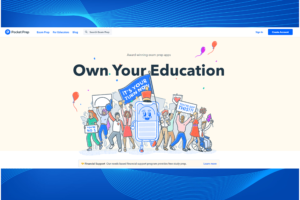Table of Contents
ToggleIntroducing Rosetta Stone Review
Rosetta Stone is a prominent language-learning platform that has been in operation since 1992. It is known for its immersive approach to language education, offering over 20 languages including popular choices like Spanish, French, German, and Japanese, as well as less common languages such as Farsi and Tagalog. The platform is designed to cater to learners at various proficiency levels, from beginners to advanced speakers.
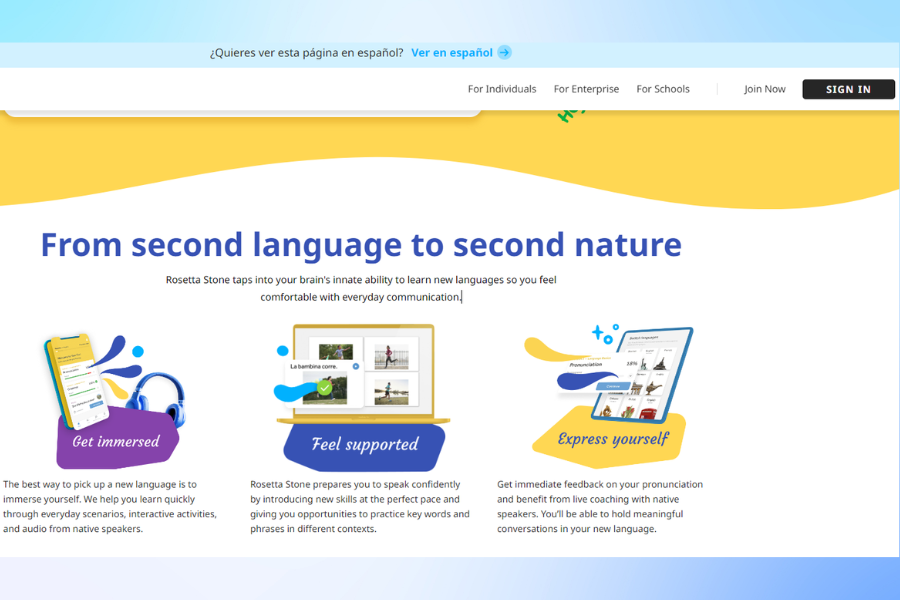
Introducing Rosetta Stone Review
Methodology and Features
Rosetta Stone employs a Dynamic Immersion method, which emphasizes learning through context rather than translation. This approach encourages learners to intuitively understand vocabulary and grammar through repeated exposure to the language in various scenarios. Key features include:
- Immersive Learning: All lessons are conducted in the target language, promoting a natural learning environment.
- Speech Recognition Technology: The platform includes TruAccent, a proprietary speech recognition tool that provides immediate feedback on pronunciation, helping users refine their speaking skills.
- Live Tutoring: Users can engage in live sessions with native speakers, allowing for real-time conversation practice and personalized feedback.
- Interactive Stories and Activities: These elements help reinforce vocabulary and comprehension in a fun and engaging way.
- Mobile and Offline Access: The platform is accessible via desktop and mobile apps, and users can download audio companions for offline study.
Pricing and Plans
Rosetta Stone offers several subscription options:
- Monthly Subscription: Starting at approximately $13.99 per month.
- Annual Subscription: More cost-effective for long-term learners, with prices typically lower than the monthly plan when calculated annually.
- Lifetime Subscription: A one-time payment option that grants unlimited access to all languages, often available at a discounted rate.
Additionally, a 30-day money-back guarantee allows users to try the service risk-free.
Pros:
- Comprehensive coverage of essential language skills: reading, writing, listening, and speaking.
- Strong emphasis on pronunciation and vocabulary acquisition.
- Flexible learning pace with personalized study plans.
- Access to a wide variety of languages, including niche options.
Cons:
- Some users find the lack of explicit grammar instruction a drawback.
- The immersive method may not suit everyone, particularly those who prefer more structured learning.
- Repetitive exercises can lead to boredom over time.
Rosetta Stone provides customer support through various channels, including email, phone, and live chat. Users have reported positive experiences with quick response times and effective issue resolution.
Rosetta Stone remains a well-regarded option for language learners due to its immersive methodology and comprehensive course offerings. While it has some limitations, particularly regarding cultural context and grammar instruction, many users find it effective for achieving conversational proficiency in a new language. The platform’s flexibility, combined with its innovative features, makes it a valuable tool for anyone looking to learn a language.
How effective is Rosetta Stone compared to other language learning methods
The effectiveness of Rosetta Stone compared to other language learning methods has been a topic of discussion among educators and learners alike. While Rosetta Stone employs a unique immersive approach, its effectiveness can vary based on individual learning styles and preferences. Here’s a comprehensive comparison of Rosetta Stone with other popular language learning methods.

How effective is Rosetta Stone compared to other language learning methods
Rosetta Stone’s Approach
Immersive LearningRosetta Stone utilizes a Dynamic Immersion method, where learners are exposed to the target language without translations. This approach is designed to mimic the natural way children learn their first language, focusing on context and association rather than explicit grammar rules.
- Pros:
- Strong emphasis on pronunciation and speaking skills through real-time feedback.
- Comprehensive coverage of vocabulary and phrases.
- Engaging multimedia content, including native audio and visual aids.
- Cons:
- Lack of explicit grammar instruction can be a drawback for some learners.
- The repetitive nature of exercises may lead to boredom.
- Limited cultural context can hinder deeper understanding of the language.
Comparison with Other Methods
| Method | Strengths | Weaknesses |
|---|---|---|
| Rosetta Stone | Immersive, pronunciation focus, multimedia use | Lacks grammar instruction, can be repetitive |
| Duolingo | Free, gamified learning, bite-sized lessons | Less depth in conversational practice |
| Pimsleur | Audio-focused, great for pronunciation | Limited vocabulary exposure, no visual aids |
| Babbel | Structured lessons with grammar explanations | Subscription cost, less focus on speaking |
| Fluenz | Emphasizes grammar and cultural context | More expensive, less immersive |
| Classroom Learning | Interactive and social, immediate feedback | Less flexible, can be intimidating for some |
Research Findings
- Effectiveness Studies: Research indicates that after approximately 55 hours of study with Rosetta Stone, learners can achieve a level of proficiency comparable to one semester of college-level language study. However, it is noted that while Rosetta Stone can deliver success in vocabulary and pronunciation, it may not fully replace the benefits of a traditional classroom setting, which often includes more interactive and communicative practice.
- User Experience: Many users report that Rosetta Stone is enjoyable and easy to use, with a high satisfaction rate. However, some find it frustrating due to its lack of explicit grammar instruction and cultural context, which are often crucial for achieving fluency.
- Complementary Use: Some learners find the best results by combining Rosetta Stone with other methods. For example, using Duolingo for vocabulary practice alongside Rosetta Stone’s immersion can provide a more rounded learning experience. Similarly, incorporating conversation practice through platforms like italki or attending language exchange meetups can enhance speaking skills that Rosetta Stone may not fully develop.
Rosetta Stone can be an effective language learning tool, particularly for beginners who benefit from its immersive and intuitive approach. However, its limitations in grammar instruction and cultural context suggest that it may be most effective when used alongside other language learning methods. Ultimately, the best approach to language learning will depend on individual goals, preferences, and learning styles.
What are the main differences between the Rosetta Stone software and the online platform
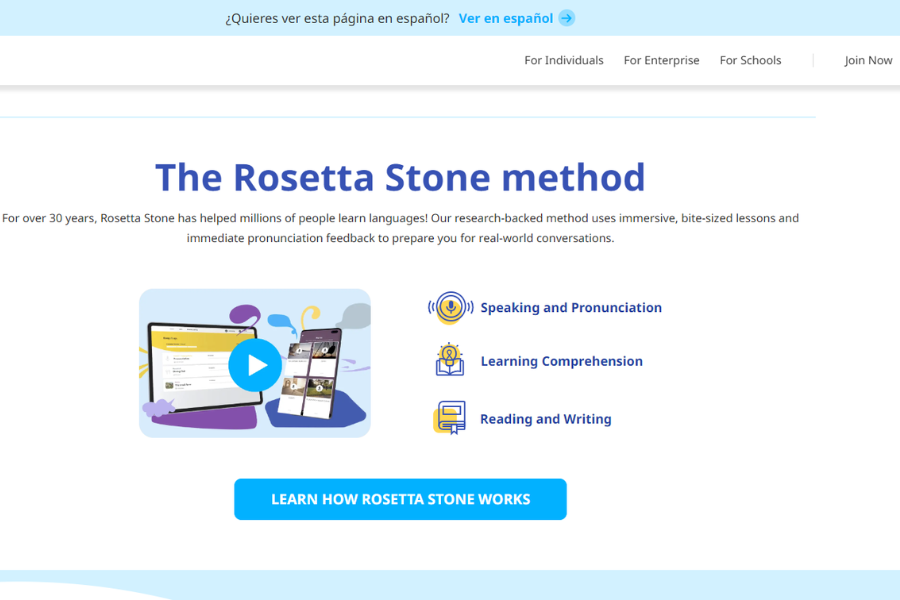
What are the main differences between the Rosetta Stone software and the online platform
- Software Version: The traditional Rosetta Stone software is installed on a computer and requires specific operating systems (historically compatible with older versions of Windows and Mac). It often relies on Adobe AIR, which may not be supported on modern systems without additional configurations.
- Online Platform: The online version is web-based, meaning it can be accessed from any device with an internet connection, including desktops, laptops, tablets, and smartphones. This flexibility allows users to learn on-the-go without the need for installation.
- Software Version: The software typically includes core lessons that are structured and may lack the interactive features found in the online version. It focuses on immersion learning, where users are exposed to the target language without translations. However, it has been criticized for repetitive exercises and a lack of explicit grammar instruction.
- Online Platform: The online platform enhances the learning experience with additional features such as live tutoring sessions, interactive stories, and a broader range of multimedia resources. It also includes mobile-exclusive features that encourage real-world interaction, such as the “Seek and Speak” tool, which allows users to practice language skills in their environment.
- Software Version: The software version may not receive regular updates, leading to potential obsolescence as technology evolves. Users might miss out on new features or language packs that are only available through the online platform.
- Online Platform: The online version is continuously updated, providing users with the latest content, features, and improvements. Subscribers can access a wider array of languages and learning materials, including community resources and interactive games.
- Software Version: Users typically pay a one-time fee for the software and any additional language packs. This can be cost-effective in the long run but may require a larger upfront investment.
- Online Platform: The online platform operates on a subscription model, offering various plans (monthly, yearly, or lifetime) that provide access to all languages and features. This model allows for more flexibility in terms of cost and access to content.
- Software Version: The interface of the traditional software can feel outdated compared to modern applications. Users may find it less intuitive and engaging, particularly if they are accustomed to more interactive learning environments.
- Online Platform: The online platform generally features a more modern, user-friendly interface that is designed for ease of use across devices. It incorporates gamification elements and progress tracking, enhancing user engagement and motivation.
Can Rosetta Stone be used for professional language certification
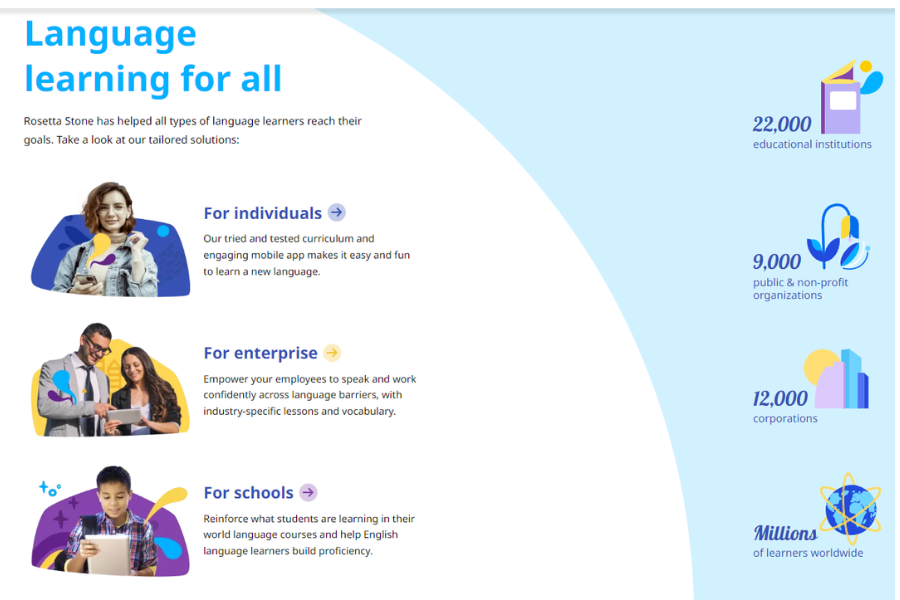
Can Rosetta Stone be used for professional language certification
Understanding Language Certification
Language certifications are formal qualifications that assess and certify an individual’s proficiency in a language. These certifications are typically recognized by educational institutions and employers and are often aligned with frameworks such as the Common European Framework of Reference for Languages (CEFR), which categorizes language proficiency into six levels: A1, A2, B1, B2, C1, and C2.Types of Recognized Certifications
To obtain a recognized language certification, individuals usually need to pass standardized tests administered by accredited institutions. Some widely accepted certifications include:- IELTS (International English Language Testing System)
- TOEFL (Test of English as a Foreign Language)
- DELE (Diploma de Español como Lengua Extranjera) for Spanish
- DALF (Diplôme Approfondi de Langue Française) for French
Rosetta Stone’s Role
While Rosetta Stone offers a comprehensive language learning experience, including reading, writing, speaking, and listening skills, it does not provide formal certification. Instead, it is recognized for its educational value and has received certifications such as the A-G certification from the University of California, which allows students to earn course credits towards graduation.How Rosetta Stone Can Help
- Foundational Skills: Rosetta Stone can help learners build foundational language skills that are essential for passing certification exams.
- Self-Study Support: It provides a flexible learning environment that can complement traditional classroom instruction, making it easier for learners to prepare for exams at their own pace.
- Gamification and Immersive Learning: The platform uses gamification and an immersive approach to enhance engagement and retention, which can be beneficial for learners aiming to reach higher proficiency levels.
What languages are available on Rosetta Stone

What languages are available on Rosetta Stone
Rosetta Stone currently offers language courses for 25 languages at various levels:
- Arabic (Modern Standard) — 3 levels.
- Chinese (Mandarin) — 5 levels.
- Dutch — 3 levels.
- English (American) — 5 levels.
- English (British) — 5 levels.
- Farsi (Persian) — 3 levels
- French — 5 levels.
- German — 5 levels.
- Greek (Modern) — 3 levels.
- Hebrew — 3 levels.
- Hindi — 3 levels.
- Italian — 5 levels.
- Irish — 3 levels
- Japanese — 3 levels.
- Korean — 3 levels.
- Latin — 3 levels.
- Polish — 3 levels.
- Portuguese (Brazil) — 3 levels.
- Russian — 5 levels.
- Spanish (Latin America) — 5 levels.
- Spanish (Spain) — 5 levels.
- Swedish — 3 levels.
- Tagalog (Filipino) — 3 levels.
- Turkish — 3 levels.
- Vietnamese — 3 levels.
Additionally, through Rosetta Stone’s Endangered Languages Program, indigenous communities can access courses for languages like Kanien’kéha (Mohawk), Sitimaxa (Chitimacha), Iñupiaq, Diné Bizaad (Navajo), Inuttitut, and Objiwe. The languages available may vary depending on the specific Rosetta Stone product or platform. For example, some languages may not be available on all platforms.
How effective is Rosetta Stone compared to other language learning apps
When it comes to language learning apps, Rosetta Stone has a long-standing reputation, but its effectiveness compared to other apps depends on various factors, such as learning style, goals, and preferences. Here’s an analysis of how Rosetta Stone compares to other popular language learning apps like Duolingo, Babbel, and Memrise:

How effective is Rosetta Stone compared to other language learning apps
1. Learning Approach
- Rosetta Stone: It uses an immersion method where users learn the language without relying on translations. This method mirrors how native speakers acquire their language, associating images with words and phrases. The focus is on building intuition around language use, which is helpful for developing long-term memory.
- Duolingo: This app is gamified, making learning fun with points, rewards, and streaks. It uses a translation-based approach, which might be easier for beginners but doesn’t create the same immersion experience as Rosetta Stone.
- Babbel: Babbel offers more of a conversational approach, teaching users practical phrases that are immediately usable in real-life situations. It includes grammar explanations and cultural insights, which some learners find beneficial.
- Memrise: Memrise combines spaced repetition with user-generated content, often using mnemonics to reinforce vocabulary retention.
2. Depth of Learning
- Rosetta Stone: The app is highly effective for developing speaking, listening, and reading skills. However, it can sometimes feel slow for users who want a quicker, more interactive experience with grammar and conversation practice.
- Duolingo: Great for beginners who want to start with basic vocabulary and grammar, but the learning curve might plateau at intermediate levels, lacking depth in conversational practice.
- Babbel: This app dives deeper into grammar and sentence structures, which makes it more useful for learners aiming to become conversational at a quicker pace.
- Memrise: Memrise excels at helping learners memorize vocabulary through repetition, but like Duolingo, it can lack depth in advanced grammar and conversations.
3. User Experience
- Rosetta Stone: The app is sleek and user-friendly but follows a more traditional structure. It’s designed for learners who want a disciplined and methodical experience. The immersion technique can feel slow for those who prefer immediate explanations or quick progress.
- Duolingo: Highly engaging due to its game-like interface. It motivates users to keep learning through rewards and streaks, making it ideal for casual learners who want a more fun, bite-sized approach.
- Babbel: Offers structured lessons that feel more like a classroom environment. It strikes a balance between fun and serious learning, with real-world examples.
- Memrise: Memrise’s strength lies in its spaced repetition system, and it allows learners to access a wide variety of user-generated content. However, the interface might not appeal to everyone, as it feels less polished compared to other apps.
4. Flexibility & Customization
- Rosetta Stone: Lacks much flexibility in lesson progression. You have to follow their structured program, which can feel limiting if you want to focus on specific areas like vocabulary or grammar.
- Duolingo: Offers much more flexibility, allowing learners to jump between lessons, revisit old ones, or try new languages. However, this can sometimes make the learning experience feel less coherent.
- Babbel: Similar to Rosetta Stone in its progressive lesson structure, but you have more freedom to pick and choose what lessons to prioritize, especially in terms of practical conversation topics.
- Memrise: Highly flexible due to the wide variety of courses available, including official courses and community-made content.
5. Speaking Practice
- Rosetta Stone: Excellent for speaking practice with its speech recognition tool, which evaluates pronunciation. This is a strong point for Rosetta Stone compared to most other apps.
- Duolingo: Offers some pronunciation exercises, but they’re not as advanced or robust as Rosetta Stone’s.
- Babbel: Includes speaking exercises, but its focus is more on practical dialogue rather than intensive pronunciation training.
- Memrise: Focuses more on vocabulary retention and less on speaking practice, though it does offer some video clips of native speakers.
6. Languages Offered
- Rosetta Stone: Offers around 24 languages. It is ideal for people who are serious about mastering a specific language, but its selection is more limited compared to other apps.
- Duolingo: Has a larger offering with 40+ languages, including fictional ones like Klingon and High Valyrian.
- Babbel: Focuses on 14 major languages, catering to the most widely spoken and popular languages for business or travel.
- Memrise: Offers a wide variety of languages, including lesser-known ones, and it allows users to create content for any language they want.
7. Pricing
- Rosetta Stone: Known to be one of the more expensive options. Subscription prices vary, but they offer a lifetime subscription that can be attractive for long-term learners.
- Duolingo: Free, with a premium option called Duolingo Plus, which removes ads and offers offline access.
- Babbel: Requires a paid subscription, but it’s usually more affordable than Rosetta Stone, with frequent discounts.
- Memrise: Offers a free version, but most advanced features are behind a premium subscription, which is relatively affordable.
8. Who It’s Best For
- Rosetta Stone: Best suited for learners who are serious about building a strong foundation in the language through immersion and are willing to invest time and money into a more methodical approach.
- Duolingo: Great for casual learners or beginners who want to make language learning a habit, but may not be sufficient for reaching advanced fluency.
- Babbel: Ideal for people looking to become conversational in a relatively short time, especially if they are focused on practical usage.
- Memrise: Perfect for learners who enjoy visual learning and memorizing vocabulary through mnemonics.
Rosetta Stone is highly effective for learners who want a traditional, immersive approach and are serious about long-term language acquisition. It excels in speaking practice and pronunciation, making it superior for users focused on fluency in speaking. However, for beginners or learners looking for a more casual, interactive experience, apps like Duolingo and Babbel might be more engaging and better suited to everyday conversational practice. For those focused on memorization and flexibility, Memrise can be a great option.
What are the main benefits of Rosetta Stone’s immersive approach
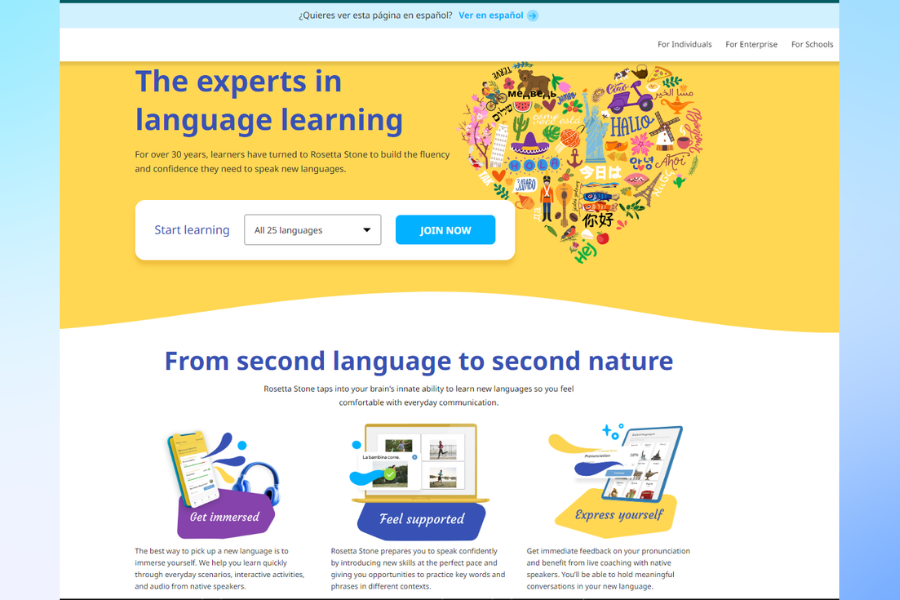
What are the main benefits of Rosetta Stone’s immersive approach.
Rosetta Stone’s immersive approach to language learning offers several significant benefits that contribute to effective and long-lasting language acquisition:
-
Natural Language Acquisition: By mimicking the way we learned our first language, Rosetta Stone immerses learners in the new language without relying on translations. This encourages thinking directly in the target language, leading to more intuitive and fluent communication.
-
Contextual Learning: The program uses images, sounds, and real-life scenarios to teach vocabulary and grammar in context. This helps learners understand not just the meanings of words but also how to use them appropriately in various situations.
-
Enhanced Memory Retention: Associating words and phrases with visual and auditory stimuli strengthens memory retention. The multisensory engagement activates different parts of the brain, making it easier to recall information later.
-
Improved Pronunciation and Listening Skills: Rosetta Stone incorporates speech recognition technology and listening exercises that provide immediate feedback. This helps learners refine their pronunciation and develop better listening comprehension skills, which are crucial for real-world conversations.
-
Elimination of Translation Dependency: By avoiding translation to the native language, learners reduce cognitive load and can process information more quickly. This direct association between the new language and its meanings accelerates the learning process.
-
Cultural Immersion: The immersive approach often includes cultural nuances, idioms, and expressions that are essential for true fluency. Understanding cultural context enhances communication skills and makes interactions more meaningful.
-
Flexible Learning Pace: Learners can progress at their own speed, revisiting lessons as needed. This personalized approach accommodates different learning styles and schedules, making it more effective than one-size-fits-all methods.
-
Engaging and Interactive Experience: Interactive activities and real-time feedback keep learners engaged. The variety of exercises prevents monotony, which can boost motivation and encourage consistent practice.
By focusing on immersion, Rosetta Stone helps learners build a solid foundation in the new language, promoting confidence and competence in real-life communication.
How does Rosetta Stone’s immersive approach compare to other language learning methods
Rosetta Stone’s immersive approach, known as Dynamic Immersion, significantly differs from other language learning methods, particularly in its emphasis on natural language acquisition without reliance on translation. Here’s a comparative overview of Rosetta Stone’s method against other popular language learning approaches:

How does Rosetta Stone’s immersive approach compare to other language learning methods
1. Dynamic Immersion vs. Traditional Methods
- Rosetta Stone: Utilizes a fully immersive environment where learners are surrounded by the target language from the outset. This method mimics how children learn their native language, focusing on context and visual cues rather than memorization or translation. Learners connect words and phrases directly to images and scenarios, fostering intuitive understanding.
- Traditional Methods: Often emphasize rote memorization, grammar rules, and vocabulary lists, which can lead to a more fragmented understanding of the language. These methods may include translation exercises that can hinder the ability to think directly in the target language.
2. Comparison with Other Apps
- Duolingo: While Duolingo incorporates gamification and is user-friendly, it often relies on translation and less immersive techniques. Users engage in repetitive exercises that may not adequately prepare them for real-life conversations. Rosetta Stone, in contrast, aims for deeper engagement through its immersive exercises, which are designed to develop conversational skills more effectively.
- Mango Languages: Similar to Rosetta Stone, Mango offers an immersive experience but includes more explicit grammar instruction and translation features. While both platforms aim to teach through context, Rosetta Stone’s approach is more focused on visual learning and intuitive language acquisition without direct translations.
3. Speech Recognition Technology
Rosetta Stone’s TruAccent feature provides immediate feedback on pronunciation, allowing learners to refine their speaking skills in real-time. This technology is integrated into the immersive experience, enhancing the learning process by helping users develop a more native-like accent. Other platforms may offer speech recognition but often lack the same level of integration and feedback specificity.
4. Cultural Context
Rosetta Stone incorporates cultural elements into its lessons, aiming to provide a broader understanding of the language within its cultural context. However, some critiques point out that these portrayals can be oversimplified. In contrast, other methods may not emphasize cultural context as strongly, potentially leaving learners with a less nuanced understanding of language use in different social settings.
5. Learning Flexibility
Rosetta Stone offers flexibility in learning, allowing users to study on various devices and at their own pace. This adaptability is crucial for modern learners who may have busy schedules. Other apps like Duolingo also provide flexibility but may not match the immersive experience that Rosetta Stone offers.
Overall, Rosetta Stone’s immersive approach stands out for its focus on natural language acquisition, real-world application, and integrated speech recognition technology. While it may not cover grammar as extensively as some learners prefer, its methodology is designed to foster fluency and confidence in speaking, setting it apart from more traditional or gamified language learning methods.
What are the limitations of Rosetta Stone’s immersive approach
Rosetta Stone’s immersive approach to language learning focuses on teaching new languages in a way that mirrors how people learn their first language: through context, images, and repetition, without explicit translations or grammar explanations. While this method has its advantages, it also comes with several limitations:
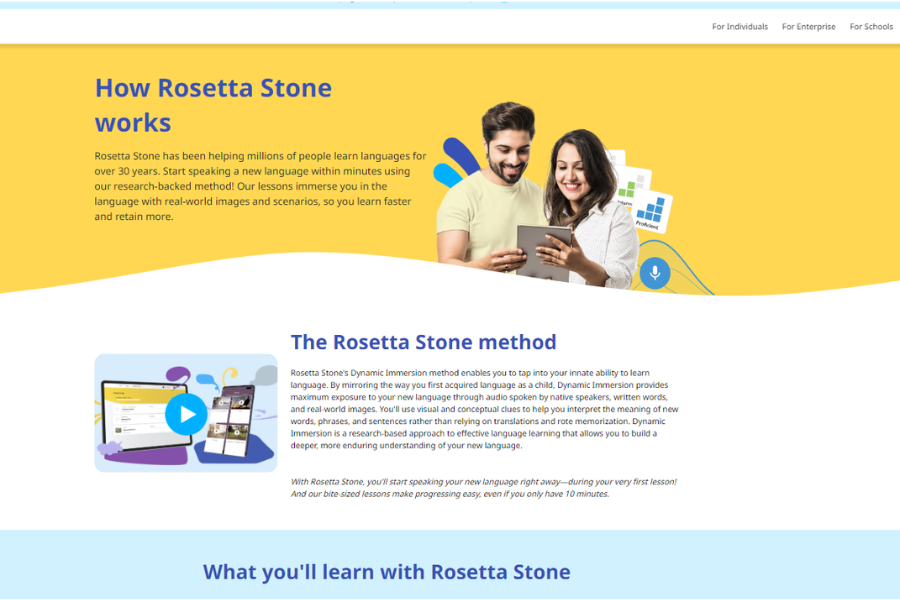
What are the limitations of Rosetta Stone’s immersive approach
-
Lack of Explicit Grammar Instruction: The program often does not provide clear explanations of grammar rules. For learners who benefit from understanding the underlying structure of a language, this can be a significant drawback. Complex grammatical concepts may remain confusing without direct instruction.
-
Challenges for Adult Learners: Adults typically process new information differently than children. While immersion works well for young learners, adults often benefit from explicit explanations and translations. The absence of these can make the learning process slower and more frustrating.
-
Limited Vocabulary Scope: Rosetta Stone may not cover a broad enough range of vocabulary and phrases needed for advanced proficiency. The focus is often on basic and intermediate levels, which might not meet the needs of learners aiming for fluency.
-
One-Size-Fits-All Methodology: The program employs a uniform teaching style that may not cater to different learning preferences. Some individuals learn better through auditory means, others through reading and writing, but Rosetta Stone heavily emphasizes visual learning through images.
-
Lack of Cultural Context: Understanding a language involves more than just vocabulary and grammar; it includes cultural nuances, idioms, and colloquial expressions. Rosetta Stone’s approach may not provide sufficient cultural immersion, limiting a learner’s ability to use the language naturally in real-world settings.
-
Minimal Interaction with Native Speakers: Real-life conversation practice is crucial for language acquisition. Rosetta Stone’s software-based approach offers limited opportunities for speaking with native speakers, which can impede the development of conversational skills and proper pronunciation.
-
Potential for Misinterpretation: Relying on images to convey meaning can sometimes lead to misunderstandings. Without translations or explanations, learners might misinterpret the context of words or phrases.
-
Cost Considerations: Rosetta Stone is often more expensive than other language learning resources, which may offer similar or even more comprehensive content at a lower price point.
-
Lack of Personalized Feedback: Automated responses and assessments may not address individual learner mistakes effectively. Personalized feedback from a teacher or tutor can significantly enhance learning by targeting specific areas of weakness.
-
Technical Limitations: Users may encounter technical issues with the software, such as compatibility problems or glitches, which can disrupt the learning process.
-
Motivation and Engagement: The repetitive nature of the exercises may lead to decreased motivation over time. Without varied and engaging content, learners might find it challenging to stay committed to the program.
-
Not Suitable for All Language Goals: For learners interested in specialized language skills, such as business language, academic terminology, or slang, Rosetta Stone may not offer the targeted content they require.
While Rosetta Stone’s immersive approach can be effective for some learners, especially at the beginner level, its limitations make it less suitable for those who need explicit instruction, cultural context, or advanced language skills. Learners may find greater success by supplementing Rosetta Stone with other resources, such as language classes, tutoring, or interactive platforms that offer a more holistic and personalized learning experience.
How effective is Rosetta Stone’s TruAccent technology in improving pronunciation
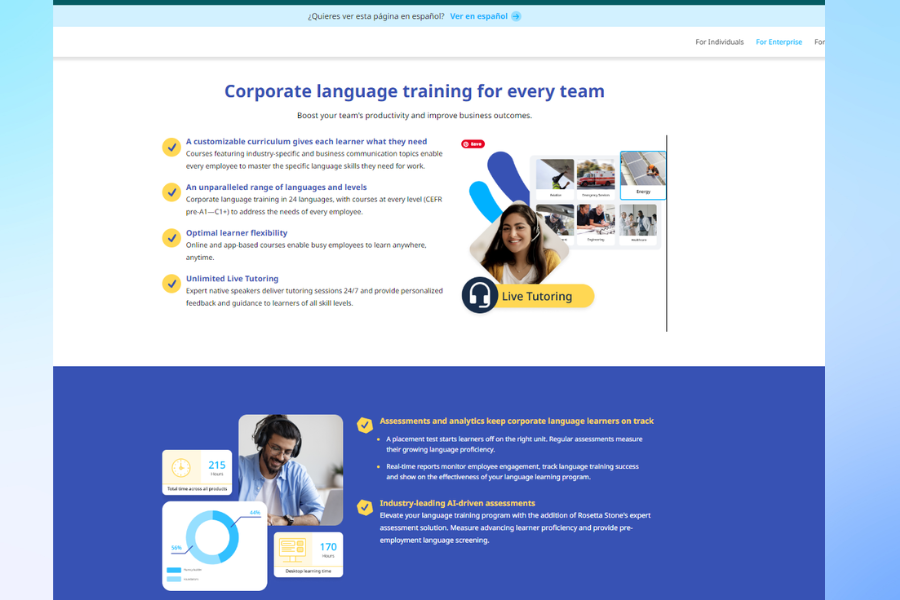
How effective is Rosetta Stone’s TruAccent technology in improving pronunciation
Effectiveness of TruAccent Technology
- Accurate Feedback: TruAccent analyzes the sounds produced by learners and compares them to millions of native speech samples. It offers personalized scoring and immediate feedback, which is crucial for mastering pronunciation and reducing accents. This technology is noted for its effectiveness in helping learners align their pronunciation closely with that of native speakers, thereby fostering fluency and confidence in communication.
- User Experience: Many users find TruAccent to be generally effective at honing pronunciation skills. However, some feedback indicates that the system may struggle with certain accents or dialects, leading to inconsistent evaluations of pronunciation accuracy. Users have reported instances where the technology either overestimated or underestimated their pronunciation accuracy.
- Comparative Performance: TruAccent is often compared favorably to similar technologies offered by competitors like Babbel, with users noting its high accuracy and effectiveness in providing pronunciation feedback that resembles real human interaction. While it is not a substitute for conversation with native speakers, it serves as a valuable tool for practice.
- Learning Environment: The technology encourages learners to practice speaking under pressure, which is beneficial for language acquisition. By requiring learners to produce language spontaneously, it helps break the habit of waiting until one feels “ready” to speak.
- Customization and Flexibility: TruAccent allows users to adjust the sensitivity of the scoring system based on their proficiency level, which can help tailor the learning experience to individual needs.
Conclusion: Is Rosetta Stone Review Worth Using to Learn a Language?
Rosetta Stone is a well-known language learning program that has garnered mixed reviews regarding its effectiveness and value. Here’s an overview of its strengths and weaknesses, along with insights on whether it’s worth the investment for language learners.
Strengths of Rosetta Stone
- Immersive Learning Approach: Rosetta Stone employs an immersion method, teaching users entirely in the target language without translations. This can help learners think directly in the new language, which is beneficial for developing fluency.
- Comprehensive Skill Development: The program covers all aspects of language learning, including speaking, listening, reading, and writing. It emphasizes pronunciation through its TruAccent speech recognition technology, which provides feedback on users’ speaking skills.
- Structured Progression: The lessons are well-structured and designed to gradually introduce vocabulary and grammar, making it suitable for beginners who need a solid foundation.
- Supplementary Features: Rosetta Stone includes additional resources such as live tutoring sessions and interactive features like Seek & Speak, which can enhance the learning experience.
Weaknesses of Rosetta Stone
- High Cost: Rosetta Stone is one of the more expensive options on the market, with prices starting around $80 for a three-month subscription and up to $299 for a lifetime access plan. This pricing may deter some learners, especially when free or cheaper alternatives exist.
- Lack of Explicit Grammar Instruction: Critics point out that while Rosetta Stone teaches vocabulary and phrases, it often lacks detailed grammar explanations, which can leave learners confused about language structure.
- Repetitive and Monotonous: Some users find the exercises repetitive and the learning process slow-paced, which can lead to boredom over time.
- Limited Real-World Application: While it builds a good foundation, many users report that they struggle with real-life conversations after completing the program. Additional practice with native speakers or other resources may be necessary to achieve fluency.
Is Rosetta Stone Worth It?
Rosetta Stone can be a valuable tool for beginners looking to establish a solid foundation in a new language. Its immersive approach and structured lessons are effective for learning vocabulary and pronunciation. However, for learners seeking in-depth grammar instruction or looking to engage in spontaneous conversation, it may not be sufficient on its own.For those who are serious about language learning, it is advisable to use Rosetta Stone in conjunction with other resources, such as grammar books or conversation practice with native speakers. If you are willing to invest the time and possibly supplement your learning, Rosetta Stone can be worth it, especially for informal study or travel purposes.
CTA: Ready to embark on your language learning journey? Start mastering new languages with Rosetta Stone today and unlock a world of opportunities.








